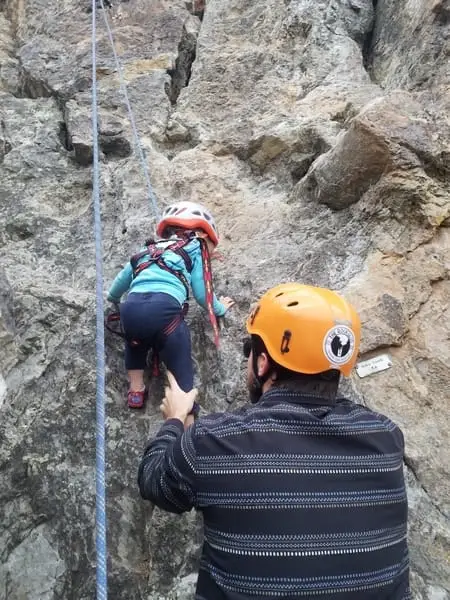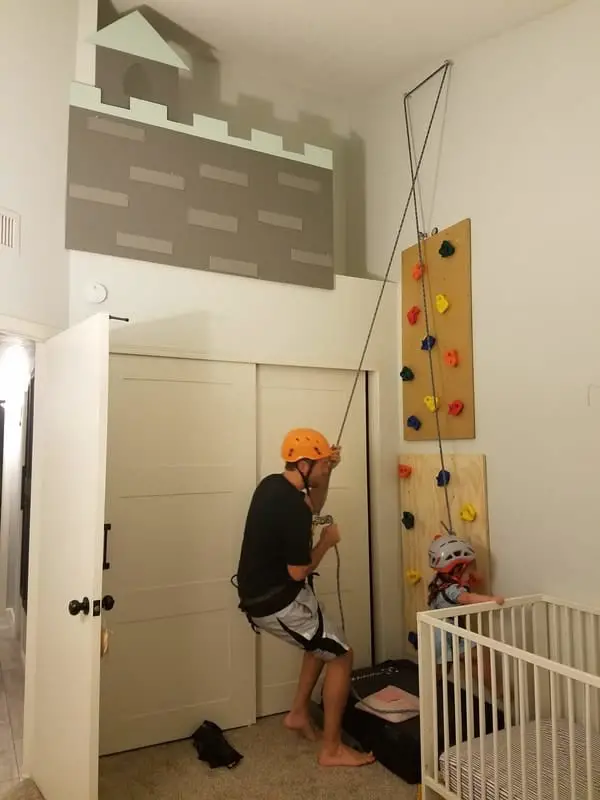For many kids, their first exposure comes from a climbing-themed birthday party at an indoor gym or a visit from a relative who climbs. Others have parents who climb or used to climb, and they sort of grow up surrounded by it.
Kids should start climbing as soon as they show interest. Toddlers begin climbing things between 12 and 24 months, and can start rock climbing as early as age 4. Most climbing gyms teach classes to kids from age 6 on. Most professional rock climbers started before age 10. There are lots of benefits of climbing for kids, physically, mentally, and socially.
There are many benefits to rock climbing at a young age, beyond just having fun and getting outside. As they say, ‘if they can walk, put them on the rock!’ Here are some of the benefits, along with more information on what to expect for kids at a climbing gym and some background on the ages professional climbers started.
See also: Tips for Climbing and Bouldering with Kids

8 Benefits of Rock Climbing for Kids
The benefits kids gain from rock climbing start immediately, and follow them through their whole lives. Most of these benefits are substantial for climbers of any age. Some of these benefits happen from climbing one time, and others require a consistent approach.
Improves Confidence/Self-Esteem
Kids face a lot of confidence and self-esteem problems, from how they look to how smart they are. Rock climbing is an activity and environment that allows them to start somewhere and steadily improve.
A big part of climbing is mental instead of physical, so any kid can have fun and improve. I’m always humbled when a 12 year old girl flies up a route I struggled on!
Increases Activity
Much has been said and published about the levels of inactivity and obesity in kids throughout the world. Rock climbing is a full body workout, and getting kids interested will help them develop a positive relationship with exercise and activity. As with any other physical sport, climbing helps to encourage kids to move.
Aside from the obvious physical benefits of activity, a Norwegian study by Tonje Zahl found that physically active children are less depressed (Source: Norwegian University of Science and Technology, 2017).
“Being active, getting sweaty and roughhousing offer more than just physical health benefits. They also protect against depression,”- Tonje Zahl
For more information, see our article written by a Registered Dietitian, Does Rock Climbing Burn Fat?
Enhanced Problem Solving Skills
Rock climbing and bouldering help kids to solve difficult puzzles and to iteratively try different combinations of moves until they ‘solve’ the problem (bouldering routes are actually called ‘problems’). This helps with brain development as well as grit and resilience. The rating of the route means that it is possible, but the climber has to figure out the correct sequence to get to the top.

Fitness for Life
Climbing is an activity that you can pretty much do throughout your whole life. A lot of schools have been shifting towards lifetime fitness activities instead of traditional sports because it’s not always easy to get a full team together in order to play football or volleyball in the real world. Climbing is an activity that can be done alone indoors, or with a friend outdoors.
The main idea behind fitness for life is that kids should try out as many activities as they can while they’re young so that they can find a few that really resonate with them. This will help them stay healthy and active as they grow into adulthood. Climbing is fun, and can be practiced year-round. It’s a great activity to get kids involved in.
See also: Can I go Rock Climbing without a Partner?
Boosts Memory/Cognitive Skills
Researchers from the University of North Florida found that “proprioceptively dynamic activities like climbing” quickly improve core executive functions like working memory and cognitive skills (Source: UNF, 2015).
The basic idea is that activities that both challenge us physically as well as mentally exercise our brains and our bodies at the same time. This specific study, which involved asking adults to climb trees, showed that the participants’ capacity for working memory increased 50 percent as soon as two hours after climbing.
According to graduate researcher Ross Alloway , “This research has wide-ranging implications for everyone from kids to adults. By taking a break to do activities that are unpredictable and require us to consciously adapt our movements, we can boost our working memory to perform better in the classroom and the boardroom.”
, “This research has wide-ranging implications for everyone from kids to adults. By taking a break to do activities that are unpredictable and require us to consciously adapt our movements, we can boost our working memory to perform better in the classroom and the boardroom.”
Develops Spacial Awareness/Motor Skills
Climbing helps kids fine-tune their motor skills. They practice pinpoint placement of feet and hands while on the rock, intentionally making each move. Additionally, climbing helps develop a good sense of spacial awareness, balance, and body control.
Risk Assessment
There are some risks involved in rock climbing, from the ever-present risk of rockfall outdoors to the chance of twisting an ankle bouldering. Climbing helps kids to understand and evaluate levels of risk and decide what they are comfortable with.
They are able to address these risks and mitigate them with proper technique, focus, and equipment. They learn to trust the gear setup even though they may not feel like they are safe, which helps them prioritize intuition over emotions. Kids learn to take responsibility for their actions and behaviors.

Forges Social Relationships
One of the best aspects of rock climbing is the social connections that are formed at gyms or outdoors at the crag. While the sport can be competitive, with competitions and teams, most of the competition is internal. You are competing with the version of yourself from the day before, working to improve and get better.
Most climbers never get involved in competitions with others, so there isn’t a lot of comparison. Because we all have different levels of experience and different capabilities, we try not to judge each other or make unhealthy comparisons.
Socially, climbing is a great environment to make friends and get involved in. One of the primary reasons for this is that most forms of climbing require a partner.
Because everyone needs a friend, there’s a lot of support and encouragement all around. Most gyms have a partner finder board, and many have specific nights dedicated to helping single or solo climbers find partners.
The relationship between a climber and a belayer needs to be rock-solid (pun intended). This is a great way for kids to learn to trust their partners and support each other’s successes.
Hanging out at a climbing gym or a crag is a fun way to spend a day and get to know other climbers. There is definitely a community around rock climbing, and kids make up a part of it.
Do Climbing Gyms Have Age Limits or Restrictions?
I took a look at 10 climbing gyms around the United States to see at what ages they start classes, camps, and teams. All of the indoor climbing gyms started teaching climbing classes to kids by at least age 6, with several starting at age 4 and 5. None of these gyms had a minimum age requirement, so kids are generally welcome at any age.
Young kids require parental supervision and help belaying. Most gyms don’t allow kids younger than about 15 to belay without a comprehensive class and test, and even then don’t allow them to belay until they’re at least 10 years old.
We used to bring our daughter to the gym with us and she could nap in her carseat or sit nearby and chew on carabiners (out of the fall zone). As she got more mobile, it became more complicated and required an extra set of hands to do anything more than bouldering.
Toddlers enjoy climbing walls, but have a hard time leaning back and trusting the rope to lower. Practice lowering at heights where you can reach them before letting them go higher.

At what age did famous professional climbers start rock climbing?
We seem to always see pictures and hear stories of professional athletes in their disciplines at young ages. While a lot of this is due to parental involvement and support, some of it is clearly due to starting to train at a young age. Most famous climbers today started climbing as children in climbing gyms, though a few started outdoors with parents and family members.
Alex Honnold, Adam Ondra, Ashima Shiraishi, Tommy Caldwell, and Sasha DiGiulian all started climbing before age 10 (some as early as 5 years old). Chris Sharma, Lynn Hill, Beth Rodden, and Margo Hayes started climbing in their pre-teenage years between ages 10-15. Famous climbers from prior generations tended to start in their later teenage years or into their twenties.
| Climber | Before Age 10 | Age 10+ |
|---|---|---|
| Alex Honnold | X | |
| Margo Hayes | X | |
| Lynn Hill | X | |
| Chris Sharma | X | |
| Adam Ondra | X | |
| Tommy Caldwell | X | |
| Ashima Shiraishi | X | |
| Beth Rodden | X |
We are likely to see these beginning ages continue to lower and stay low as indoor climbing becomes more popular and youth climbing teams continue to increase in popularity. Any parents who are semi-consistent climbers will tend to take their toddlers rock climbing or at least bouldering at some point.
Katherine climbed with our oldest daughter in the womb until she was about 7 months along, so she will be able to claim that she has climbed her whole life! (see her article: Can I Go Canyoneering or Rock Climbing While Pregnant? )
)
Sources:
University of North Florida, 2015. http://www.amsciepub.com/doi/10.2466/22.PMS.120v18x1
Norwegian University of Science and Technology. (2017, January 31). Physically active children are less depressed: Children, like adults, reap physical and mental benefits from being active. ScienceDaily. Retrieved December 20, 2019 from www.sciencedaily.com/releases/2017/01/170131075131.htm https://originclimb.com/blogs/news/benefits-of-rock-climbing-for-childrenhttps://headrushtech.com/blogs/school-rock-climbing-wall/
Related Questions:
Is Rock Climbing Safe for Kids? Climbing has a reputation for being reckless and dangerous, but it doesn’t need to be when practiced safely. Gear failure is largely a myth, as all climbing gear is rated well above the strength required. The biggest risks are sprained ankles from falling while bouldering, and a very small risk of rockfall when climbing outdoors.
See our article: Is Indoor Rock Climbing Dangerous?
What Gear do Kids Need for Climbing? Kids do not need any additional gear to go bouldering, though a pair of climbing shoes will certainly help them enjoy the experience. In order to go rock climbing, they need a harness (either full body or regular waist harness, depending on their size). If you’re just starting out, rent them from a climbing gym or borrow them from a friend.
See Also:
Tips for Climbing and Bouldering with Kids

